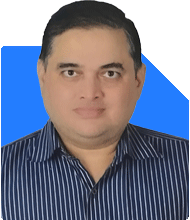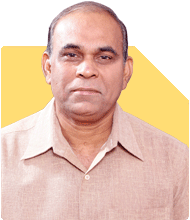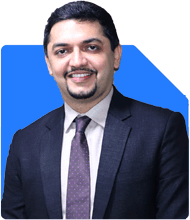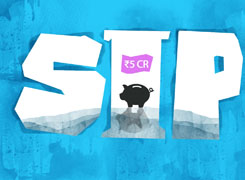Ramalingam Kalirajan |10872 Answers |Ask -Follow
Mutual Funds, Financial Planning Expert - Answered on Jun 27, 2024
He has an MBA in finance from the University of Madras and is a certified financial planner.
He is the director and chief financial planner at Holistic Investment, a Chennai-based firm that offers financial planning and wealth management advice.... more

I retrieved my message, which is as below: Hello Sir, I am NRI 40.7 years old now married with 2 kids & planning to relocate to Mumbai within next 6 months to work there for next 4 years and then retire from work. I have 4 apartments in and around Mumbai market worth Rs. 1.85 Cr(getting rent Rs. 30k each month from 3 apartments). Invested in gold worth Rs. 17lacs, invested in bajaj allianz, Tata AIA, Max life policies and monthly premium paying is Rs. 33K(bajaj started 2 years ago & rest policies started a year ago), PPF has 5K monthly payment & SSY has 1k monthly payment. At age 45, I am expecting to get Rs. 150,000 every month.
Assessing Your Current Financial Position
Firstly, it's great that you have diverse investments and assets. Your four apartments around Mumbai, valued at Rs. 1.85 Cr, generate Rs. 30,000 monthly rent from three of them. This rental income is a steady source of cash flow. Additionally, you have invested Rs. 17 lakhs in gold, which is a good hedge against inflation.
You are also committed to insurance policies, paying Rs. 33,000 monthly premiums across Bajaj Allianz, Tata AIA, and Max Life. Starting PPF and SSY contributions is a prudent step for your long-term goals. PPF has a Rs. 5,000 monthly contribution, while SSY has a Rs. 1,000 monthly contribution. These investments indicate a disciplined approach to saving for the future.
Relocating to Mumbai: Financial Implications
Moving to Mumbai within the next six months will impact your finances. Mumbai's cost of living is higher compared to many other cities. However, with careful planning, you can manage this transition smoothly. Since you plan to work in Mumbai for four years before retiring, let's ensure your finances are in order.
Evaluating Your Income and Expenses
Your rental income is Rs. 30,000 monthly, which will help cover some of your expenses. You mentioned that you expect Rs. 1,50,000 monthly income at age 45. To achieve this, a robust investment strategy is crucial.
Optimizing Your Investment Portfolio
1. Mutual Funds Over Direct Funds:
While direct funds have lower expenses, regular funds through a Certified Financial Planner (CFP) offer better guidance and support. CFPs can help you choose the best-performing funds tailored to your goals. Actively managed funds often outperform passive index funds due to professional management. Direct funds lack this personalized advice, which can be crucial for optimizing your portfolio's performance.
2. Gold Investments:
Gold worth Rs. 17 lakhs is a solid investment. However, diversifying into other asset classes can provide better returns. While gold is a safe haven, equities and mutual funds can offer higher growth potential. A balanced portfolio that includes equities, debt instruments, and gold can help you achieve a more stable and higher return over time.
3. Insurance Policies:
Your insurance premiums are significant. Ensure these policies provide adequate coverage and benefits. Review these policies with a CFP to check if they align with your financial goals. If not, consider switching to term insurance, which offers higher coverage at lower premiums. Term insurance provides the necessary financial security for your family without the high costs associated with investment-linked insurance policies.
Strategic Financial Planning for Retirement
1. Creating a Retirement Corpus:
To receive Rs. 1,50,000 monthly at age 45, you need a substantial retirement corpus. Continue investing in PPF and SSY, but also increase contributions to equity mutual funds. Equities offer higher returns over the long term, essential for building a sizable retirement corpus. By leveraging the power of compounding, your investments can grow significantly over the next few years.
2. Emergency Fund:
Maintain an emergency fund of at least six months' expenses. This fund will provide a financial cushion in case of unforeseen events. Invest this in liquid funds or high-interest savings accounts for easy access. A robust emergency fund ensures you do not have to dip into your long-term investments during emergencies.
3. Health Insurance:
Ensure you and your family have comprehensive health insurance. Medical emergencies can deplete your savings, so adequate coverage is crucial. Review your health insurance policies regularly to ensure they meet your family's needs, considering factors like critical illness cover and cashless hospital facilities.
Education and Marriage Planning for Children
1. Sukanya Samriddhi Yojana (SSY):
Your monthly investment of Rs. 1,000 in SSY for your daughter is wise. This will help cover her higher education and marriage expenses. Consider increasing this contribution if possible. The SSY offers attractive interest rates and tax benefits, making it a suitable investment for your daughter's future needs.
2. Public Provident Fund (PPF):
Your Rs. 5,000 monthly PPF contribution is beneficial for long-term goals. PPF offers tax benefits and compound interest, making it a secure investment option. Regular contributions to PPF can significantly enhance your retirement corpus due to its long-term compounding benefits.
3. Additional Investments:
For your children’s future, consider investing in child-specific mutual funds or Unit-Linked Insurance Plans (ULIPs) with good track records. These investments grow over time, ensuring funds for their education and marriage. Child-specific mutual funds are designed to align with the educational milestones and marriage expenses, offering targeted growth.
Managing Real Estate Assets
Real estate is a significant part of your portfolio. While it's a stable investment, it may not provide the highest returns compared to other asset classes. Avoid further real estate investments and focus on more liquid assets like mutual funds and equities. Liquid assets are easier to manage and can be rebalanced to adapt to changing market conditions.
Retirement Income Strategy
1. Systematic Withdrawal Plan (SWP):
Consider setting up an SWP from your mutual funds to generate a steady income during retirement. This strategy ensures regular cash flow while keeping your principal amount invested. SWPs offer the flexibility to withdraw a fixed amount periodically, providing a stable income stream without depleting your investment.
2. Equity Mutual Funds:
Invest in diversified equity mutual funds for growth. Over time, equities can provide substantial returns, essential for your retirement corpus. Choose funds with a strong track record and consistent performance to maximize returns. Diversified equity funds spread the risk across various sectors, reducing the impact of market volatility.
3. Debt Funds and Fixed Deposits:
Allocate a portion of your investments to debt funds and fixed deposits for stability. These provide lower returns but reduce risk, balancing your overall portfolio. Debt funds offer better returns than traditional fixed deposits and are more tax-efficient.
Reviewing and Adjusting Your Plan
1. Annual Reviews:
Regularly review your financial plan with a CFP. Annual reviews help track progress and make necessary adjustments based on changing market conditions and personal circumstances. Reviewing your plan ensures it remains aligned with your goals and adapts to any changes in your financial situation.
2. Tax Planning:
Optimize tax planning to maximize returns. Utilize tax-saving instruments under Section 80C, such as PPF, ELSS, and insurance premiums, to reduce taxable income. Effective tax planning can significantly enhance your net returns and help you achieve your financial goals faster.
3. Estate Planning:
Create a will and consider estate planning to ensure a smooth transfer of assets to your heirs. This step prevents legal complications and ensures your family’s financial security. Estate planning includes setting up trusts and nominations to safeguard your family's future.
Building a Robust Investment Strategy
1. Diversification:
Diversify your investments across asset classes like equities, debt, and gold. This reduces risk and enhances returns. A well-diversified portfolio can weather market volatility better and provide more stable returns.
2. Regular Investments:
Continue with regular investments through Systematic Investment Plans (SIPs). This instills financial discipline and leverages rupee cost averaging, reducing the impact of market fluctuations. Regular investments also help in building a substantial corpus over time.
3. Professional Guidance:
Work closely with a CFP to tailor your investment strategy. Their expertise can help you navigate market complexities and achieve your financial objectives. A CFP can provide personalized advice based on your risk tolerance, investment horizon, and financial goals.
Preparing for Financial Independence
1. Financial Independence Ratio:
Calculate your financial independence ratio to understand how close you are to achieving your retirement goals. This ratio compares your passive income to your expenses. A higher ratio indicates greater financial security and readiness for retirement.
2. Passive Income Streams:
Develop multiple passive income streams such as dividends, rental income, and interest from fixed deposits. This reduces dependence on a single source of income and provides financial stability. Diversified income streams can ensure a comfortable retirement lifestyle.
3. Expense Management:
Monitor and control your expenses to ensure they align with your income. Avoid unnecessary expenditures and focus on saving and investing. Effective expense management helps in maintaining a balanced budget and achieving financial goals.
Final Insights
Your financial journey is well on track with diversified investments and disciplined savings. By focusing on equities and mutual funds, you can achieve higher returns. Regular reviews with a CFP will ensure your plan adapts to changing circumstances. Avoid further real estate investments and prioritize liquidity and growth. Your goal of retiring at 45 with Rs. 1,50,000 monthly income is achievable with strategic planning and disciplined execution.
Best Regards,
K. Ramalingam, MBA, CFP,
Chief Financial Planner,
www.holisticinvestment.in
Regarding your financial health, I’d be delighted to review it. This platform has restrictions on sharing personal contact details. You can reach me through my website mentioned below for personalized financial planning and fee details.
Let's embark on this financial journey together.
Best Regards,
K. Ramalingam, MBA, CFP,
Chief Financial Planner,
www.holisticinvestment.in
You may like to see similar questions and answers below
Ramalingam Kalirajan |10872 Answers |Ask -Follow
Mutual Funds, Financial Planning Expert - Answered on Jul 10, 2024
Ramalingam Kalirajan |10872 Answers |Ask -Follow
Mutual Funds, Financial Planning Expert - Answered on Jul 11, 2024
Ramalingam Kalirajan |10872 Answers |Ask -Follow
Mutual Funds, Financial Planning Expert - Answered on Jul 12, 2024
Milind Vadjikar | Answer |Ask -Follow
Insurance, Stocks, MF, PF Expert - Answered on Oct 24, 2024
Radheshyam Zanwar |6735 Answers |Ask -Follow
MHT-CET, IIT-JEE, NEET-UG Expert - Answered on Dec 06, 2025
Dr Nagarajan J S K |2576 Answers |Ask -Follow
NEET, Medical, Pharmacy Careers - Answered on Dec 06, 2025
Mihir Tanna |1090 Answers |Ask -Follow
Tax Expert - Answered on Dec 06, 2025
Ramalingam Kalirajan |10872 Answers |Ask -Follow
Mutual Funds, Financial Planning Expert - Answered on Dec 06, 2025
Radheshyam Zanwar |6735 Answers |Ask -Follow
MHT-CET, IIT-JEE, NEET-UG Expert - Answered on Dec 06, 2025
Radheshyam Zanwar |6735 Answers |Ask -Follow
MHT-CET, IIT-JEE, NEET-UG Expert - Answered on Dec 06, 2025
Radheshyam Zanwar |6735 Answers |Ask -Follow
MHT-CET, IIT-JEE, NEET-UG Expert - Answered on Dec 06, 2025
Dr Dipankar Dutta |1837 Answers |Ask -Follow
Tech Careers and Skill Development Expert - Answered on Dec 05, 2025
Dr Shyam Jamalabad |108 Answers |Ask -Follow
Dentist - Answered on Dec 05, 2025
Dr Shyam Jamalabad |108 Answers |Ask -Follow
Dentist - Answered on Dec 05, 2025



























